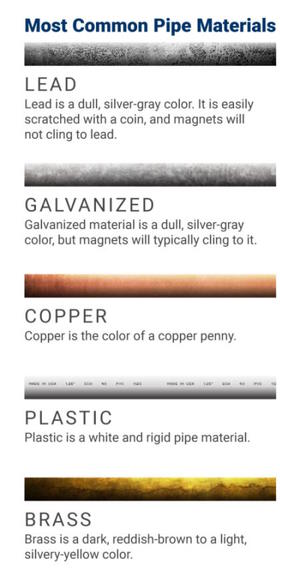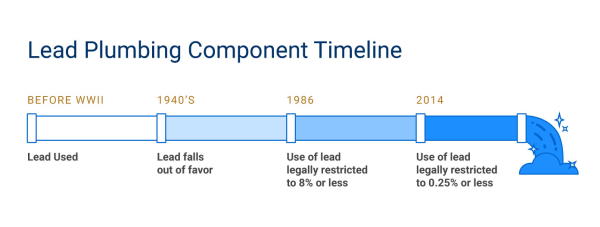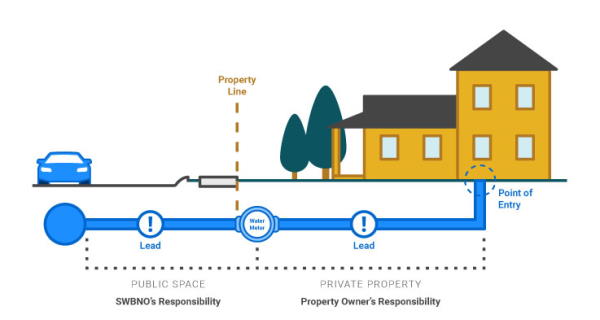Keeping You Safe from Lead
Is there lead in your plumbing? Today there’s a growing awareness that some homes have lead in water pipes, fixtures, and plumbing. Consuming lead can cause serious health problems, especially for infants, young children, and pregnant women. In the interest of public safety, the U.S. Environmental Protection Agency (EPA) introduced new regulations that require utilities across the country to phase lead service lines out of their systems more quickly than before.
Our main priority is to reliably deliver safe water to our customers. We are committed to making sure people in our community are not exposed to lead in their water. While the water leaving our drinking water treatment plant is lead-free, we recognize that lead and copper exist in some service lines in our systems as well as in interior plumbing in some homes, businesses, and schools. This puts our community at risk. To keep our customers safe, the lead must be replaced.
Where Does Lead Come From?
Even though the water leaving our treatment plants is lead-free, corrosion can cause lead from old underground service lines to dissolve into water as it travels to your taps.
Lead can also enter water through plumbing and fixtures in buildings:
- Interior lead pipes
- Interior galvanized pipes
- Interior copper pipes with lead soldered joints
- Interior fixtures
Identifying Lead
Lead contamination can be hard to detect. The effects of lead on the body happen slowly over time, and you won’t visibly see or smell lead in your tap water. One way to check for possible contamination is to determine if components of your home’s interior plumbing are made of lead.
- Lead has a dull gray color.
- If you scratch lead with a coin or key, it will scratch easily and leave a shiny silver color.
- See if a magnet sticks to the pipe. A magnet will not stick to a lead pipe.

Who is at Risk?
Lead began to fall out of favor in the 1940s as people recognized the risks of using it, but it was not legally restricted until 1986.
In 2014, the maximum amount of lead allowed in water pipes, solder, and fittings was reduced from the 1986 standard of no more than 8 percent to 0.25 percent or less.
If your home was constructed or your plumbing was replaced before these dates, lead plumbing and fixtures may exist in your home and/or in the service lines leading to your meter, putting you at risk.
Expectant mothers and children under the age of six are especially vulnerable to the effects of lead contamination.

What SWBNO is Doing About Lead?
Testing
The water leaving our drinking water treatment plant is lead-free. We confirm this through ongoing testing in compliance with state and federal regulations.
Per EPA regulations, we also test water samples from taps in homes and buildings that are at high risk of lead or copper contamination.
Treatment
As an added measure, we treat our water with a National Sanitation Foundation-certified additive to guard against corrosion. While this is a good prevention method, the best and safest solution is to have no lead in the system at all.
Inventory
Over the next three to five years, we will replace old-fashioned water meters with new, digital smart meters. As this work occurs, we will look for lead service lines and document where they are for replacement.
Replacing Lead Pipes
The responsibility for replacing lead pipes is shared between SWBNO and property owners.
If a public service line (between the meter and the street) is made of lead, SWBNO is responsible for it.
Property owners are responsible for the water service lines that run from the water meter into their buildings, as well as old faucets, taps, and plumbing inside the buildings that may contain lead.

Keep Your Home Safe
If you are concerned about lead, here are some ways you can protect your household. For more tips to reduce lead exposure from drinking water, read our 2020 Consumer Confidence Report.
Flush your tap if you haven’t used it in several hours. Allow water to run for 45 seconds to several minutes before use. This should not substantially impact your bill since a gallon of water costs less than a penny at our rates.
Always drink or cook with water from the cold tap. Water from the hot tap can hold more lead from your water heater, plumbing, or faucets.
Use a water filtration system or water filters to further reduce or eliminate exposure to lead. Select a filter certified to meet NSF Standard 53 for lead. Be sure to change the filter according to the manufacturer's recommended schedule.
Replace lead service lines and galvanized plumbing. You are responsible for replacing a lead line on your private property. Lead from lead service lines can also build up in galvanized pipes and be released later.
Ask your physician to test your child’s blood levels. Louisiana Law requires primary medical providers to perform lead testing on children ages six months to six years.
Get a Free Lead Testing Kit
TTo determine whether your home’s drinking water contains lead, consider having your water tested for lead, especially if you have young children, elderly persons, and/or a pregnant woman in your home. SWBNO will provide free lead testing for any New Orleans residence. You do not need to own your home or receive a SWBNO bill to get a free testing kit.
Here’s how to request a free testing kit:
- Contact SWBNO’s Lab at (504) 865-0420 or click here to use our online request form.
- A test kit with instructions will be mailed to your address. Kits are delivered by USPS, and return postage is provided. A signature is not required for delivery.
- Results from lead testing may take approximately six to eight weeks. All results are provided by mail. If your results are above the EPA’s action level, you will also receive notification by phone or email.
Resources
For more information, reference the following resources.